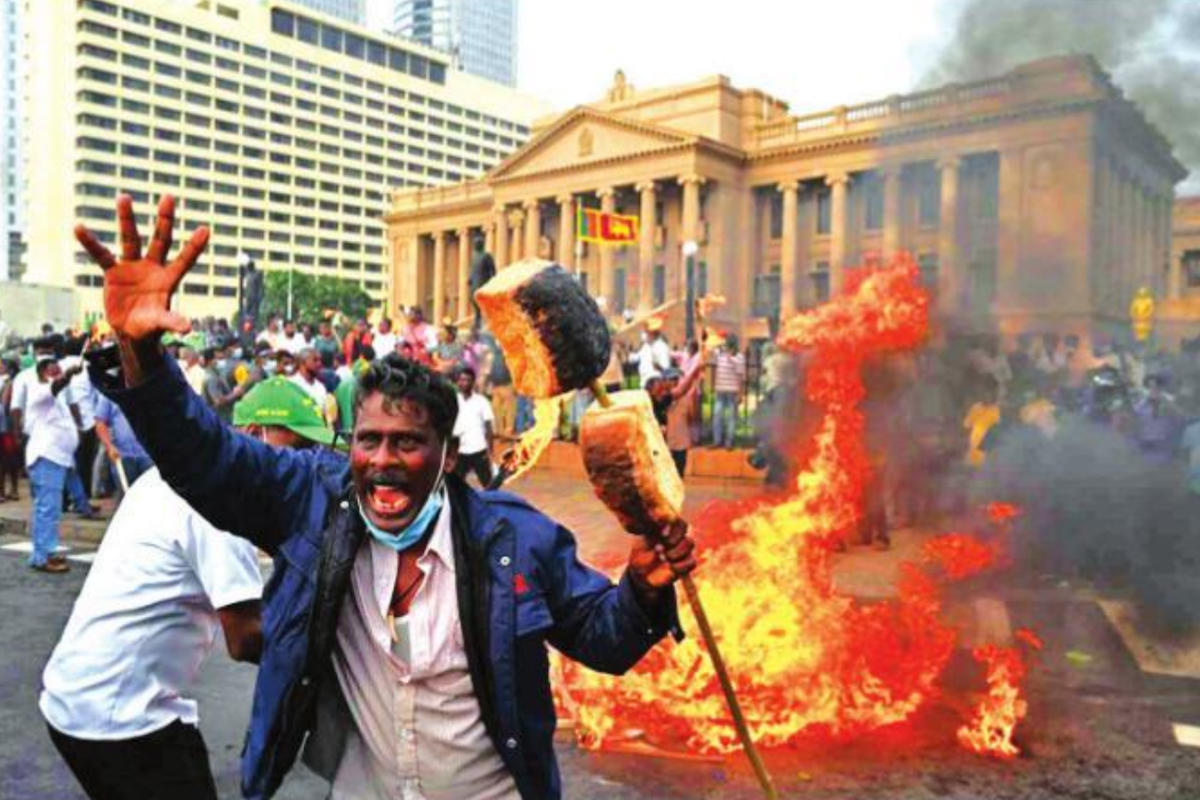Sri Lanka is going through one of the worst crises of its history. Food has become scarce, prices have shot through the roof, and long power cuts have turned the lives of ordinary Sri Lankans upside down. The economic meltdown has also catapulted the country into a political crisis as the people demand answers and accountability from the government.
After the recent attacks on protestors in the nation’s capital by supporters of the ruling party, the President imposed a new state of emergency, giving security forces sweeping powers. The ferocity of the protests has already forced Prime Minister Mahinda Rajapaksa to resign, and protestors are demanding that his brother, President Gotabaya Rajapaksa, step down as well.
The present economic crisis can be traced back to a series of bad government policies. When the Rajapaksas came to power in 2019, they made a series of tax cuts taking away significant amounts of government revenue, which, in turn, affected debt servicing. This move had a domino effect on the country’s other immediate needs and led to public finances becoming unsustainable. The root of this issue is primarily attributed to the government’s negligence towards restructuring its debt. Sri Lanka has also failed to attract foreign direct investment, and as a result of printing surplus cash, the country’s imports stood at a much higher rate than its exports.
Another bad policy with catastrophic consequences was the fertiliser ban. In April 2021, Gotabaya Rajapaksa introduced an island-wide ban on synthetic fertilizers and pesticides. For a country whose staple diet is rice, domestic production plummeted in just six months. Sri Lanka used to be self-sufficient in rice production, but thanks to Rajapksa, it now has to import over $450 million worth of rice. No country with a consultative democracy would have made such a ludicrous decision, thus highlighting how powerful the Rajapaksas had become. The pandemic further worsened the economic situation, which eventually triggered protests across the country.
Protests are not a novelty in Sri Lanka. Minorities have been doing it for decades. “Our history is very bloody,” Paramie Jayakody, a 25-year old journalist from Colombo, opines. “It has always been like that.” The minority communities in Sri Lanka have been historically persecuted and vilified by the majority Sinhalese. Paramie recollects how she was told not to associate with Tamils, one of the minority groups while growing up.
The Rajapaksas’ now-battered popularity can too be traced back to minority baiting. After the Easter Bombings of 2019 and the hysteria that followed, the promise of controlling an ‘unruly’ minority appealed to some Sinhalese Sri Lankans. Although the attack was attributed to a local Islamist terrorist group, the Muslim community in Sri Lanka was collectively vilified in the aftermath. Paramie recalls her friends with beards afraid of being perceived to be Muslim and attacked.
But the current situation has become so dire that people, irrespective of their ethnicity, religion, and language, have set aside their differences to band together. The sheer ferocity of the protests is also because of the involvement of the middle and upper-middle classes, who have badly suffered from the economic crisis as well.
Many, like Sahan Wiratunga, a 27-year-old social worker from Colombo, see the anti-Rajapaksa protests as an opportunity to heal the ethnic and religious divides in the country. These protests have brought about a newfound sense of patriotism and belonging to the people of Sri Lanka. Political awareness in Sri Lanka is low – and those who are aware are often disillusioned to find that politics is only a privilege of those who belong to the majority. However, the current situation seems to be a testament to the fact that they are capable of setting aside their differences and working together against a common adversary.
Sahan admits he was not an anti-establishment activist from the start and only began organising protests recently, along with his friends. As a result, some unexpected guests showed up at their homes – the police. Sahan, who was not at home when they arrived, had a narrow escape, but his friend was not that lucky. Along with several other activists across Sri Lanka, they were arrested for voicing their opinion against the regime. However, far from scaring the protestors, these arrests fueled their anger against the Rajapaksas, who are seen as not merely inefficient but also profoundly corrupt.
The protests against the government are intense. However, the future of Sri Lanka is unpredictable. With the air of uncertainty lingering throughout the entire country, Paramie worries about the horrors the future could entail. There are four broad possibilities – the President stepping down, a military takeover, a rebel takeover, and one where all the other parties get together for a peaceful transition into a caretaker government. Right now, she feels that the President stepping down is never going to happen. A military takeover, similar to what transpired in Myanmar, seems most likely, given the past and the current displays of power and aggravated violence.
The Sri Lankans have much to be concerned about, but the crisis has not garnered sufficient international attention – a fact that is echoed by many of the protestors. Paramie talks about how the Russia-Ukraine war is receiving large-scale global media coverage, and justifiably so, but she adds, “It would be great if more people paid attention to the current situation in Sri Lanka, and educated themselves about what is going on in my tiny country.”
(The writers are Writing Fellows with the Fellowship for Freedom in India.)










